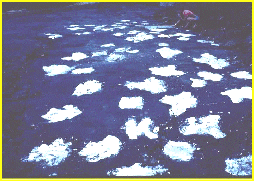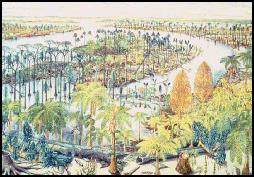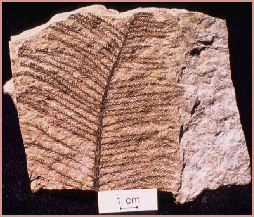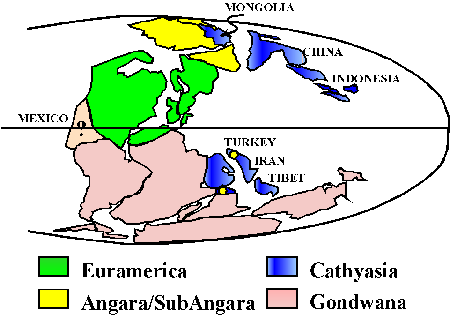CARBONIFEROUS PALEOECOLOGICAL SCENARIOS
Early Carboniferous floras (Mississippian) are poorly known because of limited outcrop exposure and study.
In general:
- Archaeopteris gallery forests are no longer inhabiting the floodplain settings reflecting a loss of the K-selected biota.

|
- Arborescent lycopsids found in the Late Devonian (Lepidodendropsis) persist into the Early Carboniferous. They
are maintained in coastal lowland wetland settings. The photograph on
the left illustrates a Lepidodendropsis forest from the
Mississippian of Virginia described by Scheckler and Beeler.
|
- Seed plants (Pteridospermales) are prolific and probably formed dense shrublands. They were r-selected, producing
large quantities of small seeds. These plants become the dominant biotic strategy in non-swamp habitats.
- Diversification of architectural types and systematic affinities continues throughout the Early Carboniferous, and
woody vines appear in the northern hemisphere.
- Ferns diversify, but appear to be relegated to small herbaceous and shrubby forms. Tree ferns are not yet known in
the stratigraphic record.
Late Carboniferous floras
are ecologically
diverse and probably best known pre-Neogene vegetation. Individual plant
groups have established characteristic biologies & ecologies, and at no other time in earth history do we see this
systematic-specific condition. The Late Carboniferous forests had the highest ecological guild structure known in the
history of terrestrial vegetation, because five major groups of plants
coexisted as equals within the forest structure.

These groups are:
LYCOPHYTES - Predominantly in coastal lowland peat and clastic swamps, and exhibiting a pole-tree
architecture. Diverse autecological behavior, and different taxa are edaphically controlled. Support of the plant was
derived from extensive bark tissues.
SPHENOPHYTES - Calamites are clonal trees, forming dense stands probably in wetland soils including lake
margins. Another order of sphenopsids, the Sphenophyllales, were ground creepers or lianas.
PTERIDOPHYTES - Diversify throughout the Late Carboniferous and Permian, and tree ferns dominate the latter
part of the Paleophytic. Potential for colonizing due to reproductive strategy of homospory. Some forms are small and
probably represent ground scramblers or lianas. Tree ferns are entirely primary tissues, supported by aerenchymatous
adventitious roots.
PTERIDOSPERMS - Large diversity in growth forms, occupying coastal lowland floodplains and probably
extrabasinal areas. Tree forms may develop to 10 meters in height, forming an understory component. Some forms
with leaves up to 7 m in length, whereas other forms are small and liana-like. Seed diversity in size & morphology
suggests a variety of ecological roles and pollination syndromes. Plants constructed of some wood and
sclerenchyma-rich cortical tissues, and probably had high growth rates.
CORDAITES - Ecologically diverse. Plays a number of roles in several sites including ground cover,
?mangrove-type habits, and significance in extrabasinal coastal lowlands where they may have developed gallery
forestation. Large, woody trees with slow growth rates and K-selected.
OTHER GYMNOSPERMS - Few extrabasinal "windows" exist, and where data is available, the floras suggest
that there is a broad-leaved flora. Extrabasinal forms include conifers (Westphalian B).
The end of the Pennsylvanian witnessed major perturbations in terrestrial communities, with the demise of the
arborescent lycopsids and the rise of tree ferns. This turnover has been
discussed by Gastaldo, DiMichele and
Pfefferkorn and Kerp.
Several Late Pennsylvanian-aged sites have yielded exquisitely
preserved soft-bodied organisms in a variety of Fossil Lagerstätten.
Take a virtual tour of these at the Illinois State Museum's Mazon
Creek site and the West Lancashire
coalfield in Great Britain.
LATE PALEOPHYTIC FLORAL COMMUNITIES
The climate in the Permian of the northern hemisphere changed dramatically and this is reflected in the floral
assemblages. Pre-Permian drying trends eliminated the swamp-centered lycophytes and increased the presence of
Marattialan tree ferns. The drying trend at the end of the Carboniferous is reflected in the proliferation of coniferalean
plants along with the "seed ferns" and true ferns.
CORDAITEAN CONIFERS
- The Cordaitales are an order included ground creepers, shrubs, mangroves, and arborescent forms. It is a
monopodial tree supported by extensive secondary xylem. Leaves are helically arranged around branches. Leaves
are large (up to 1 m), strap-like, multi-veined. Ovule-bearing and pollen-bearing cones are similar in organization
developed as a compound strobilus.
- The order, Voltziales, is believed to be
ancestral to
living conifers and subdivided into three families, two of which
are found in Permian communities:

- Walchiaceae: These trees are typified by Walchia, Ernestiodendron and Ortiseia known from Upper
Carboniferous and Permian localities. The trees had branching patterns similar to living Norfolk Island Pine
(Araucaria), and bore unisexual fructifications in cones. The female cones differ dramatically from modern
coniferous plants with a terminal ovule(s) on a dwarf shoot that adaxial to a bifurcate bract. Pollen-producing
cones are similar to modern conifers.
- Voltziaceae: These conifers differ from the Walchiaceae in the development of ovuliferous scales in the
cones.
- Rufloriaceae: These shrubby or arborescent Angaran plants have leaves similar to cordaites, and leaves of
Rufloria have been found in association with both ovuliferous (Krylovia, Bardocarpus) and pollen-producing
organs (Cladostrobus).
- Vojnovskyales: These shrubby or possibly arborescent plants dominated the Angara flora in the temperate and high
latitudes. These conifers are believed to have possessed cordaites-like leaves and a single ovuliferous structure and
leaf-like bracts.
PTERIDOSPERMS:
This group continues in the Late Paleophytic and evolves new community components that include the genus
Callipteris, a peltasperm "seed fern." These plants were probably small trees or shrubs with bifurcate leaves. The
reproductive structures are unique with 10-20 ovules attached in a ring on the underside of a peltate, disc-like organ.
These were helically arranged on a central stalk.
Once again, terrestrial perturbation in the Late Paleozoic resulted in a dramatic change in community structure. This
Permian Floral Break has been investigated by several European workers including Hans Kerp.
LATE PALEOPHYTIC FLORAL COMMUNITY DISTRIBUTION
Three (3) or four (4) major paleofloristic provinces existed in the Late Paleozoic: Gondwana, Angara/Subangara,
Cathaysian, Euramerican (the latter combined by some authors as the Circumtethys unit). The floral diversification is
due to global climate patterns reflecting the proximity glacial terrains, equatorial positions, and temperate.
 |
Paleogeographic restoration of Late Paleozoic
floras depicting the distribution of the Euramerican,
Angaran/Subangaran, Cathyasian and Gondwanan
provinces. Base map adatped from Scotese et al. (1979).
|
©Copyright 1997 by Robert A. Gastaldo. All rights reserved. No
part of
these lecture notes may be reproduced or transmitted in any form or by any
means, electronic or mechanical, including photocopy, recording, or any
information storage and retrieval system, without permission from the
author.







